

American Schools Are Training Kids for a World That Doesn't Exist. Are Americans getting dumber?

Our math skills are falling. Our reading skills are weakening. Our children have become less literate than children in many developed countries. But the crisis in American education may be more than a matter of sliding rankings on world educational performance scales. Our kids learn within a system of education devised for a world that increasingly does not exist. To become a chef, a lawyer, a philosopher or an engineer, has always been a matter of learning what these professionals do, how and why they do it, and some set of general facts that more or less describe our societies and our selves. We “learn,” and after this we “do.” This approach does not map very well to personal and professional success in America today.
Over the next twenty years the earth is predicted to add another two billion people. David Edwards About David Edwards is a professor at Harvard University and the founder of Le Laboratoire. Americans need to learn how to discover. Breaking the Mold: School Fosters Design and Discovery. Flickr: Exploratorium What do we do in a world where learning is no longer directly tied to an institution, and is being placed into the hands of the learner?

Will Richardson posed this perennial question to educators recently at the ISTE conference. His question highlights a key tension: those with control over education policy are making decisions on the old model of schooling — knowledge held by teachers who deliver information to students — while young learners are clamoring for something different.
“There’s not much I need you for when it comes to my child learning something,” Richardson said to teachers. 5 Problem-Solving Techniques For Every Aspect Of Life. “I don’t have enough time.”

“I have too many meetings.” “My experience tells me this project is doomed.” Sound familiar? You may have heard this common refrain, or some variation, at work. And it’s the opportunity to think about problems in a different way that gets Danny Schuman, president of Twist, a Chicago-based innovation and marketing consulting firm, excited to get up in the morning.
“Ideas solve problems,” says Danny Schuman, speaking earlier this week at Chicago Ideas Week. The joy of solving is recognizing how you solve problems so you can solve them better, but also finding out how others solve so you can borrow their magic, Schuman explains. Schuman spent a year interviewing 50 people in a number of fields (from technology and law to business and health care), gathering insight into how left and right-brained people approach problem solving. Through his research, Schuman identified five paths to solving any problem, business or otherwise: 1. 2. 3. Struggle Means Learning: Difference in Eastern and Western Cultures. By Alix Spiegel In 1979, when Jim Stigler was still a graduate student at the University of Michigan, he went to Japan to research teaching methods and found himself sitting in the back row of a crowded fourth-grade math class.
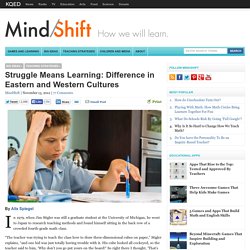
“The teacher was trying to teach the class how to draw three-dimensional cubes on paper,” Stigler explains, “and one kid was just totally having trouble with it. His cube looked all cockeyed, so the teacher said to him, ‘Why don’t you go put yours on the board?’ So right there I thought, ‘That’s interesting! He took the one who can’t do it and told him to go and put it on the board.’ ” Stigler knew that in American classrooms, it was usually the best kid in the class who was invited to the board. In Japanese classrooms, teachers consciously design tasks that are slightly beyond the capabilities of the students they teach, so the students can actually experience struggling with something just outside their reach.
But the kid didn’t break into tears. Using crafts as a method of Discovery Learning for your child - Charleston Children's Crafts. Now that school in the Charleston area is back in full swing, many parents are looking for ways to help their young children learn.
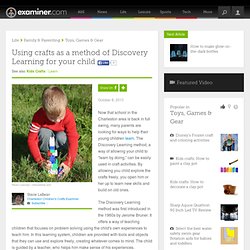
The Discovery Learning method, a way of allowing your child to “learn by doing,” can be easily used in craft activities. By allowing you child explore the crafts freely, you open him or her up to learn new skills and build on old ones. The Discovery Learning method was first introduced in the 1960s by Jerome Bruner. Discovery/Sensory/Learning Activities (Bins, Trays, Bags, Tables, Box… Discovery Learning - Educational Learning Theories. Jerome Bruner and Discovery Learning. Jerome Bruner said that knowing is a process and so his work focused on the importance of understanding the structure of a subject being studied, the need for active learning as the basis for understanding, and the importance of reasoning in learning.

Bruner believed that when learners are presented with perplexing situations they will want to figure out a solution. This belief was the basis for creating discovery learning activities. Jerome Bruner's connection with the National Science Foundation curriculum development projects of the 1960s and 1970s was instrumental in formulating discovery approaches to science learning. Bruner believed that the goal of education should be intellectual development and that the science curriculum should foster the development of problem-solving skills through inquiry and discovery. Discovery learning encourages students to actively use their intuition, imagination, and creativity. Dr. Mariappan Jawaharlal: Teaching Is not Learning. Quite often the words "teaching" and "learning" are used synonymously.
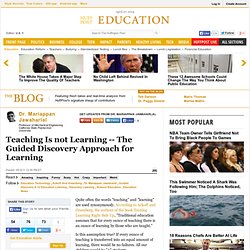
According to Ackoff and Greenberg, the authors of the book Turning Learning Right Side Up, "Traditional education assumes that for every ounce of teaching there is an ounce of learning by those who are taught. " Is this assumption true? If every ounce of teaching is transferred into an equal amount of learning, there would be no failures. All our children would be "A" students. The reality is that teaching, as the word implies, is about teachers; learning is about students. Dramatic example of discovery learning. Here is a rather dramatic example of unguided (or self-guided) discovery learning.

See also this PBS video feature on the same story. A man in India put a computer with net access in a wall next to an alley so that poor children could use it. They developed quite a fluency in its use. The man nudged them once, showing them that the computer could play music, too. But for classroom purposes, I was also interested in another little experiment he did with classroom students. Well, I tried another experiment. Then I did my usual thing: I closed the door and went off somewhere else.
They answered all five questions in two hours. That’s not a wow for the children, it’s a wow for the Internet. And I would mention now, based on the earlier papers I cited in my last post, if the teacher followed up with the children on a lesson about viscosity, they would learn even more. Castronova_litr. Discovery learning. This article or section is incomplete and its contents need further attention.
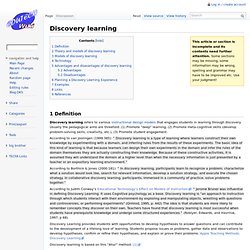
Some sections may be missing, some information may be wrong, spelling and grammar may have to be improved etc. Use your judgment! 1 Definition Discovery learning refers to various instructional design models that engages students in learning through discovery. Usually the pedagogical aims are threefold: (1) Promote "deep" learning, (2) Promote meta-cognitive skills (develop problem-solving skills, creativity, etc.), (3) Promote student engagement. What is discovery learning? - Paradigm Learning. Discovery learning is a powerful instructional approach that guides and motivates learners to explore information and concepts, embrace new knowledge, and apply new behaviors back on the job.
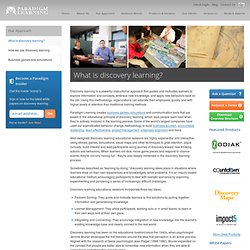
Using this methodology, organizations can educate their employees quickly and with higher levels of retention than traditional training methods. Discovery_Learning_Overview_Magical_Magnets. Discovery learning. Learning that takes place, not through instruction, but through examination, analysis, or experimentation. See also inquiry. Discovery Learning (Bruner. Discovery Learning Alliance. Discovery learning.
Jerome Bruner is often credited with originating discovery learning in the 1960s, but his ideas are very similar to those of earlier writers (e.g. John Dewey). Bruner argues that "Practice in discovering for oneself teaches one to acquire information in a way that makes that information more readily viable in problem solving" (Bruner, 1961, p. 26). This philosophy later became the discovery learning movement of the 1960s. The mantra of this philosophical movement suggests that we should 'learn by doing'. In 1991, The Grauer School, a private secondary school in Encinitas, California, was founded with the motto, "Learn by Discovery", and integrated a series of world-wide expeditions into their program for high school graduation.
Is Discovery Learning the Way to Go? - Teaching Now.